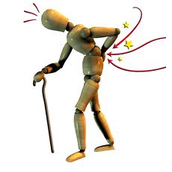Chiropractic benefit to the Joints in the Extremities
Sure, you know that chiropractic alleviates dysfunction in the spine that may
impede nervous system activity. And you know that chiropractic care wards off disability in the hips, back and neck as well. You are probably also aware that this drug-free approach to health averts headaches, jaw pain and fibromyalgia. But did you know that chiropractic offers effective correction for problems in the joints of the upper and lower limbs (extremities)? Dr. Shamaeizadeh of Soft Touch Chiropractic in Porter Ranch, CA, addresses maladies affecting the ankles, knees, wrists,elbows and shoulders with a multifaceted approach. First, alignment in the extremities is influenced by spinal posture. Consequently, a misaligned spine may spark a chain reaction that throws limbs slightly out of balance, leading to uneven wear on joints. Dr. Shamaeizadeh examines the spine for areas where movement is restricted or spinal bones (vertebrae) are slightly out of place. These dysfunctional segments are called vertebral subluxations. This condition is corrected with specialized, gentle maneuvers called chiropractic adjustments. Next, chiropractic care targets the specific joint involved. This may include gentle adjustments to or manipulation of the joint. It may also involve physiotherapy techniques or exercises custom tailored to the patient’s unique circumstances. In addition, ergonomic advice is a common component of an extremity care plan. And nutrition and stress reduction are often also inte- grated into this revolutionary approach to health. How effective is chiropractic at alleviating problems with joints in the extremities? Following is a compilation of cutting-edge research on how chiropractic care benefits particular joints. Wonderful Wrists A growing body of research indicates that chiropractic care is a winning solution for wrist pain due to carpal tunnel syndrome (CTS) and the lesser- known conditions that mimic it. In one experiment, doctors at Northwestern College of Chiropractic in Bloomington, Minn., followed 96 individuals with CTS. The patients received either medical or chiropractic intervention. Medical treatment consisted of medication (ibuprofen) and nighttime wrist supports. Chiropractic care included adjustments to the wrist and spine, ultrasound therapy and nighttime wrist supports. Findings showed that the drug-free chiropractic approach was as effective as medical treatment, without the potentially hazardous side effects of painkillers (J Manipulative PhysiolTherapy 1998;21:317-26).Chiropractic care is also effective for the lesser-known disorders that are often misdiagnosed as CTS. One such condition is ulnar tunnel syndrome (UTS). One scientific case study tracked a 45-year-old woman with UTS. Her symptoms resolved following four chiropractic visits during which she received wrist adjustments (J Manipulative Physiol Ther2003;26:602-7). Excellent Elbows Chiropractic adjustments alleviate common elbow problems, such as“tennis elbow” (lateral epicondylitis) and “golfer’s elbow” (medial epicondylitis).Research conducted at The University of Queensland in St. Lucia, Australia reveals that a specific type of adjustment to the elbow produces an immediate and dramatic drop in pain for patients with tennis elbow. As part of the study, researchers tested pain-free grip strength in 24 patients before and after receiving manipulation to the elbow or a placebo procedure.Findings showed “a significant and substantial increase in pain-free grip strength of 58 percent” during treatment but not during placebo and control (Man Therapy 2003;6:205-12).Another case study examined a woman with elbow pain triggered by repetitive work activities. A course of chiropractic adjustments to the elbow joint ended the woman’s pain and increased motion in the joint (J Manipulative Physiol Therapy 2000;23:619-22). And, in another analysis, 24 patients with long-term elbow pain received either a placebo treatment or manipulative therapy. Findings showed “a significant and substantial increase” in the pain-free grip strength of 58 percent during treatment — but not during placebo or non treatment phases (Manual Therapy 2001;6:205-12). Curiously, adjustments to the wrist may also keep elbow conditions at bay. One experiment enrolled 28 patients with tennis elbow. The subjects received either manipulation of the wrist or a standard physical therapy protocol (ultrasound, friction massage, muscle stretching and strengthening exercises). After three weeks of intervention, the success rate among manipulation recipients was 62 percent, compared with 20 percent in the physical therapy group. After six weeks, the manipulation group reported significantly greater improvement in pain, compared with the physical therapy recipients (5.2 out of 11 vs. 3.2 out of 11,respectively). ( P h y s Therapy 2003;83:608-16). Click the Like button below
rel=”author”>Masoud Shamaeizadeh
1 Comment
|
New Patient SpecialArchives
July 2024
Categories |


 RSS Feed
RSS Feed
